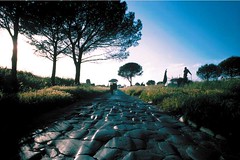Historic preservation problems all over

Alamy photo. The Via Appia was first recognised as an important historical legacy by Napoleon, but preserving it is proving to be an uphill struggle
From "Appian Way blighted by voracious property developers," in the Independent:
It was the first modern road in the world, shooting like an arrow from the Porta Capena in Rome's city walls all the way to Brindisi on the Adriatic coast, more than 500km (300 miles) away. Today the Via Appia is at the centre of a regional park, protected by the city of Rome and Unesco as the patrimony of all humanity. At least that is the theory. But although it has become a popular weekend draw for Romans and visitors, the Via Appia is in trouble.
Twenty years ago the regional government passed a law to protect it, but despite its Unesco listing it is fighting off colonisation by property speculators gambling on the likelihood that Silvio Berlusconi will win Italy's upcoming election and his government will, like his two previous ones, enact a condono or amnesty on illegal building.
Sixteen illegally built villas have been condemned and demolished in the park in the past five years, but many have survived. And the way the amnesty law works poses a vivid threat to the park's integrity.
During the last amnesty enacted by Mr Berlusconi, in 2003, 90,000 applications were made for the regularisation of illegal buildings in Rome alone. But officials given the task of vetting them believe one-third referred to structures as yet unbuilt, allowing their authors to go ahead and build them, secure in the knowledge that they could not be stopped. It was the fourth such amnesty in as many decades.
Labels: historic preservation



0 Comments:
Post a Comment
<< Home